Explore Luang Prabang - Laos Travel, Asia
Luang Prabang, nestled in northern Laos at the meeting point of the Mekong river and Nam Khan river, is a city celebrated for its rich cultural heritage and stunning natural beauty. Recognized as a UNESCO World Heritage Site in 1995, it boasts a unique blend of traditional Lao and French architecture that has been carefully preserved. Whether you're wandering through its ancient temples, admiring the local architecture, or soaking in the natural beauty of waterfalls and rivers, Luang Prabang offers something for everyone.
Population: Approximately 470,000 in 2020.
Economy: Luang Prabang's economy thrives on tourism, with its UNESCO status drawing visitors to its temples, natural wonders, and cultural experiences. Local crafts, hospitality, and small businesses also play vital roles, supporting the town's sustainable growth. Local crafts, hospitality, and small businesses also play vital roles, supporting the town's sustainable growth.
Landmarks: Famous for the Wat Xieng Thong, Royal Palace Museum (also known as Haw Kham), and Mount Phousi (Phou Si Hill).Luang Prabang, nestled in northern Laos at the meeting point of the Mekong river and Nam Khan river, is a city celebrated for its rich cultural heritage and stunning natural beauty. Recognized as a UNESCO World Heritage Site in 1995, it boasts a unique blend of traditional Lao and French architecture that has been carefully preserved. Whether you're wandering through its ancient temples, admiring the local architecture, or soaking in the natural beauty of waterfalls and rivers, Luang Prabang offers something for everyone.
Population: Approximately 470,000 in 2020.
Economy: Luang Prabang's economy thrives on tourism, with its UNESCO status drawing visitors to its temples, natural wonders, and cultural experiences. Local crafts, hospitality, and small businesses also play vital roles, supporting the town's sustainable growth. Local crafts, hospitality, and small businesses also play vital roles, supporting the town's sustainable growth.
Landmarks: Famous for the Wat Xieng Thong, Royal Palace Museum (also known as Haw Kham), and Mount Phousi (Phou Si Hill).
Laos
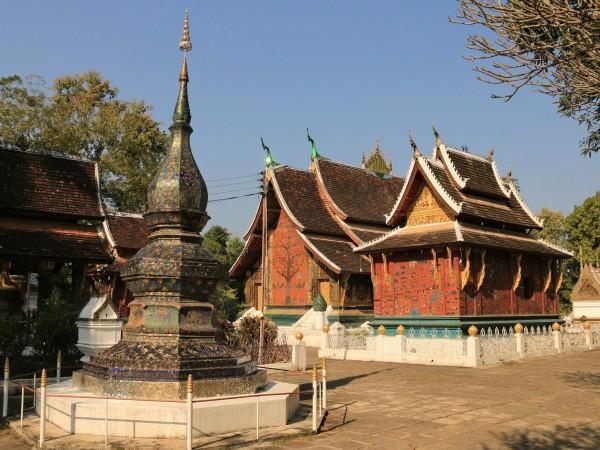
Overview of Luang Prabang
History & Cultural Influence
Luang Prabang's rich history and cultural influence have made it one of Southeast Asia’s most captivating cities. Archaeological evidence traces its origins back to 8,000 BC, establishing it as a city with deep cultural roots. Over time, Luang Prabang developed into a hub for Buddhist learning and artistic expression with the arrival of the sacred golden Buddha, Phra Bang, in 1512, which gave the city its current name. The French colonial period in the late 19th century introduced European architectural elements, blending beautifully with traditional Lao structures, a fusion that still defines the city today. Declared a UNESCO World Heritage Site in 1995, Luang Prabang’s well-preserved mix of cultural influences continues to charm visitors.
Interaction with The Locals
Luang Prabang is home to a population mixed primarily of Lao ethnicity. The town's citizens maintain strong cultural ties, with Buddhism playing a central role in daily life. You'll often see monks in saffron robes, highlighting the deep spiritual connection of the community. Despite the growing tourism, the people of Luang Prabang have preserved their traditional ways, blending them seamlessly with modern influences. This balance gives the town its unique charm and cultural authenticity.
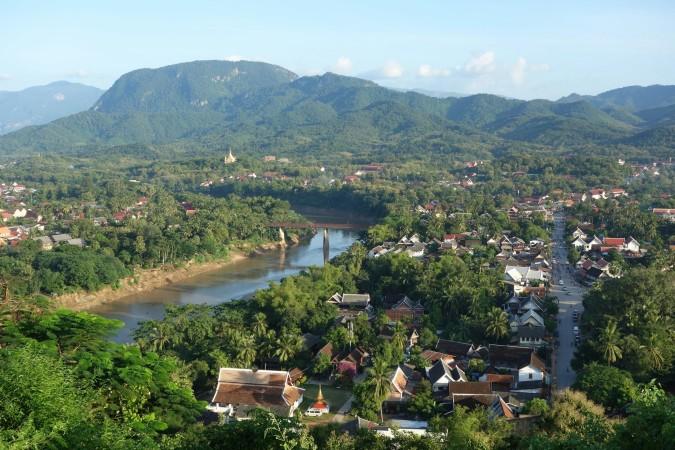
Luang Prabang, Laos - © CJ Botha
Top Attractions in Luang Prabang
Kuang Si Falls
Kuang Si Falls is a stunning natural wonder that you won't want to miss. This three-tier waterfall, surrounded by lush jungle, offers refreshing turquoise pools where you can take a dip to cool off. If you're feeling adventurous, a hike to the top rewards you with incredible panoramic views. Plus, nearby is a bear sanctuary where you can learn about efforts to protect rescued Asiatic black bears, adding a meaningful touch to your visit.
Wat Xieng Thong
Wat Xieng Thong is one of the most visually striking temples in all of Laos. Built in 1560, its sweeping roof and intricate mosaics make it an architectural masterpiece. This temple is a perfect reflection of the city's deep spiritual and cultural heritage, and wandering its grounds feels like stepping back in time. If you’re interested in history and culture, this is an essential stop.
Mount Phousi
For unbeatable views of Luang Prabang, a climb up Mount Phousi is a must. The 328 steps might sound daunting, but the reward is worth it—panoramic views over the city, the Mekong, and Nam Khan rivers. At the summit, you'll find Wat Chom Si, a peaceful temple that's a favorite spot for watching the sunset and painting the sky in stunning colors. It’s a perfect blend of physical activity and serene beauty.
Royal Palace Museum (Haw Kham)
The Royal Palace Museum is a window into the royal history of Laos. Once the residence of the royal family, the building itself is a beautiful mix of French colonial and traditional Lao architecture. Inside, you’ll discover artifacts and personal belongings that offer a fascinating glimpse into the royal lifestyle. It’s an insightful stop for anyone interested in the history and culture of this charming city.
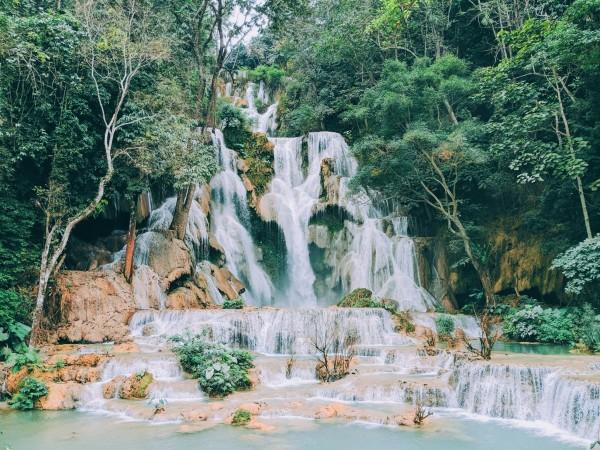
Kuang Si Falls - © note thanun
Must-Try Dishes in Luang Prabang
- Or Lam: Or Lam is a hearty, flavorful stew that truly represents the rustic cuisine of Luang Prabang. Made with tender buffalo meat, vegetables, and a unique local herb called "sakhan," this dish is a must-try for anyone looking to experience authentic Lao flavors.
- Jaew Bong: Known as the "soul" of Lao cuisine, Jaew Bong is a spicy, smoky chili paste made from dried chilies, garlic, shallots, and often buffalo skin. It’s a staple condiment in Luang Prabang and pairs beautifully with sticky rice or grilled meats.
- Khai Pen: Khai Pen is a unique local snack made from dried river weed harvested from the Mekong River. Lightly fried with sesame seeds and garlic, it offers a crispy texture and subtle flavors that highlight the significance of the Mekong in Luang Prabang’s culinary traditions.
- Sai Oua: Sai Oua is a fragrant pork sausage packed with local herbs like lemongrass, ginger, and kaffir lime leaves. Grilled to perfection, this street food favorite is bursting with flavor and showcases the region’s skill in blending aromatic ingredients.
- Khao Soi: Luang Prabang’s version of Khao Soi is a noodle soup dish that’s a bit different from the Thai version. This comforting bowl features wide rice noodles in a rich, tomato-based broth, topped with minced pork, fermented soybeans, and a drizzle of chili oil.

Or Lam - © Saeng's Kitchen
Festivals & Local Celebrations
Pi Mai Lao (Lao New Year)
Pi Mai Lao is the biggest and most important festival in Luang Prabang, and visitors are in for an unforgettable experience. Expect lively water-splashing festivities across the city, a grand parade with locals dressed in beautiful traditional costumes, and even an elephant procession through the streets. The celebration also includes a beauty pageant to crown "Miss Lao New Year," sand stupa building along the Mekong River, and a sacred ceremony at Wat Mai where the Prabang Buddha statue is displayed for a special watering ritual.
Boun Lai Heua Fai (Festival of Light)
Marking the end of Buddhist Lent, Boun Lai Heua Fai is a magical festival that lights up the Mekong River with thousands of handmade boats illuminated by candles. Visitors can witness colorful boat processions, homes and temples adorned with glowing lanterns, and a lively atmosphere as locals pay homage to the water spirits, hoping for good fortune in the coming year.
Hmong New Year
Celebrating the unique culture of the Hmong ethnic minority, Hmong New Year is a vibrant festival filled with tradition. Visitors will see Hmong people dressed in their finest traditional attire, enjoy musical performances, and experience cultural ceremonies. One highlight is the traditional game "pov pob," or ball tossing, which is a key part of the celebration, offering an authentic glimpse into Hmong customs and community spirit.
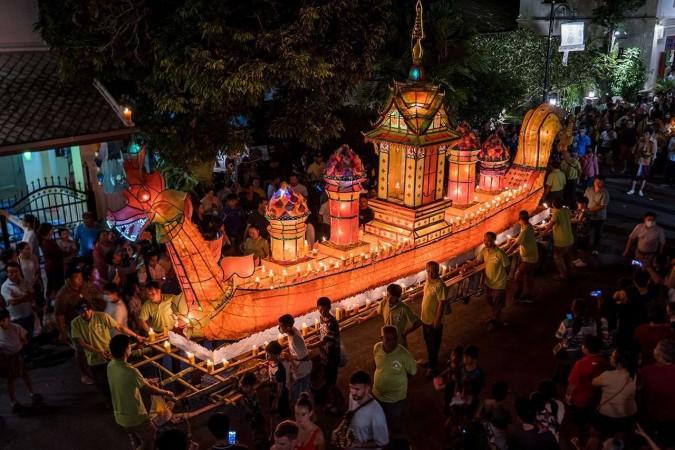
Boun Lai Heua Fai (Festival of Light) - © Ock Pop Tok
What to Do in Luang Prabang
- Outdoor Adventures: For nature enthusiasts, Kuang Si Waterfall is a must-visit destination. You can swim in its turquoise pools, hike through lush trails, and explore the nearby bear sanctuary. Additionally, a Mekong River cruise offers a serene way to soak in the stunning landscapes and observe local fishing practices.
- Cultural Experiences: Immerse yourself in the rich heritage of Luang Prabang by participating in a traditional Buddhist almsgiving ceremony (Tak Bat) at dawn. This serene experience allows visitors to witness the daily lives of monks and engage in meaningful cultural practices.
- Temple Tours: The town is dotted with beautiful temples. A guided tour can take you to iconic sites like Wat Xieng Thong and Wat Phu Si, where you can admire intricate architecture and learn about the spiritual significance of these places.
Shopping in Luang Prabang
- Night Market: Located in the heart of Luang Prabang, the Night Market is a must-visit for travelers seeking handmade crafts, textiles, and traditional clothing. Open every evening from 17:00 to 22:00, this lively market offers a wide variety of local goods, making it a perfect spot to pick up unique souvenirs.
- Ban Xang Khong: This traditional neighborhood is famous for its papermaking and textile work. Visitors can discover beautiful handmade paper products, lanterns, and high-quality silk and cotton fabrics here, making it a unique shopping destination.
- Ock Pop Tok Store: Centrally located in Luang Prabang, Ock Pop Tok is known for its high-quality silk, hemp, and cotton textiles. They offer a mix of contemporary and traditional designs, providing a diverse range of beautiful fabrics.
- Ban Phan Luang: Known for its expertise in silver and bronze work, Ban Phan Luang is a hub for traditional jewelry and decorative items. Visitors can find beautifully crafted pieces that reflect the local artistry.
- Khinthong Lao Silk: Specializing in handwoven textiles by Tai Daeng women, Khinthong Lao Silk is known for intricate patterns and beautiful fabrics, making it a great stop for anyone interested in traditional Lao weaving.
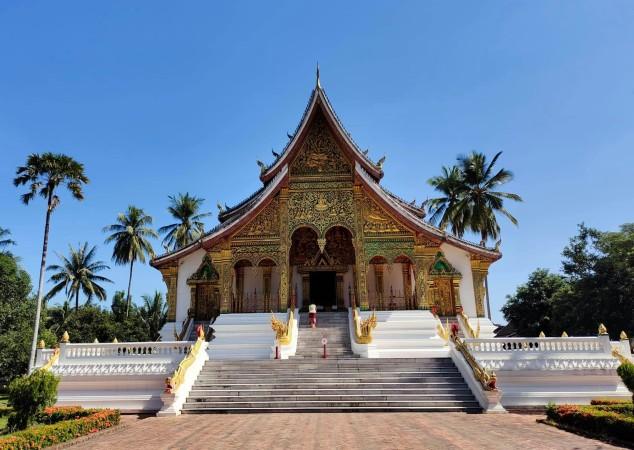
Wat Xieng Thong - © Life on the road
Weather in Luang Prabang: Best Time to Visit
The city experiences a tropical monsoon climate with distinct seasons: dry, wet, and cool. Understanding the weather pattern in Luang Prabang will help you make the most of your visit to this wonderful land.
Dry Season in Luang Prabang
The dry season is the most popular time to visit Luang Prabang. Temperatures range from 15°C (59°F) at night to around 30°C (86°F) during the day. The weather is generally sunny and pleasant, making it ideal for exploring the town's attractions and outdoor activities. Visitors can enjoy the vibrant atmosphere of local festivals, such as the Lao New Year in April.
Wet Season in Luang Prabang
The wet season in Luang Prabang is characterized by high humidity and frequent rainfall. From April to October, temperatures typically hover between 23°C (73°F) and 33°C (91°F). While the rain can be heavy at times, it often comes in short bursts, allowing for sunny spells. This season brings lush greenery to the landscape, making it a beautiful time for nature lovers to visit, particularly the stunning Kuang Si Waterfall.
Cool Season in Luang Prabang
During the cool season, temperatures can drop to around 10°C (50°F) at night, while daytime temperatures range from 20°C (68°F) to 25°C (77°F). This season is ideal for those who prefer milder weather and fewer crowds. It's a wonderful time to experience local culture, including temple visits and traditional ceremonies, as the cool temperatures make exploring comfortable.
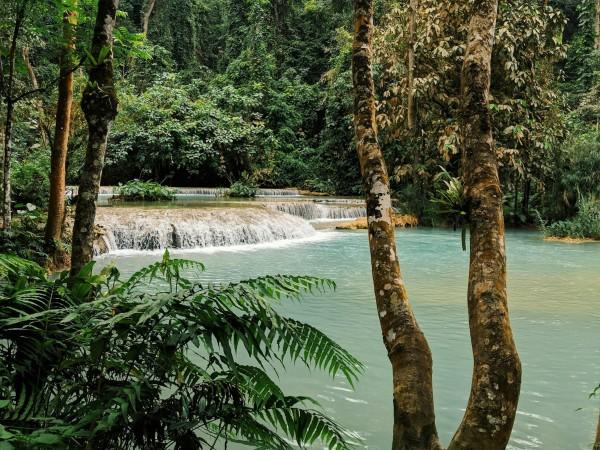
Experience Luang Prabang's untouched nature - © note thanun
Essential Travel Information
Getting Around Luang Prabang
- Public Transit: There is no regular public bus system within Luang Prabang, but taxis and tuk-tuks are common. Tuk-tuks are the main form of public transportation, though it’s best to negotiate the fare before your ride.
- Taxis and Tuk-tuks: Taxis can be hired but are not as widespread as tuk-tuks, which are a more popular option for getting around. Remember to settle on a price with tuk-tuk drivers before starting your journey.
- Motorbikes: Motorbikes are a popular choice for tourists wanting to explore more freely and are available for rent in the city.
- Walking: The city center is compact and easy to explore on foot. With four main roads running along the peninsula where the Nam Khan and Mekong Rivers meet, walking is often the most pleasant way to experience the local sights.
- Boat: For a unique experience, slow boat services on the Mekong River take travelers from Huay Xai to Luang Prabang, a journey that spans two relaxing days.
ATM and Banking Services
- ATM Availability: Luang Prabang is well-equipped with over 1,300 ATMs across Laos, many of which are conveniently located in key areas such as airports, market squares, and popular tourist spots.
- Card Acceptance: Most ATMs in Luang Prabang accept Visa, Mastercard, Cirrus, Plus, JCB, and American Express. However, cards like Diners, Discover, and RuPay may have limited acceptance, so it’s best to check beforehand.
Where to Stay in Luang Prabang
- Luxury Resorts: If you're looking for a more indulgent experience, luxury resorts in Luang Prabang offer stunning views and exceptional amenities. Many of these resorts are situated along the Mekong River or nestled in lush gardens, providing a peaceful retreat. Guests can enjoy spa services, fine dining, and guided excursions to explore the area's natural beauty.
- Boutique Hotels: Luang Prabang is also home to several boutique hotels that combine comfort with local charm. These establishments often feature traditional Laotian architecture and decor, creating a unique ambiance. Many boutique hotels also offer personalized services, including guided tours and cooking classes, ensuring a memorable stay.
- Guesthouses & Homestays: For budget travelers, numerous guesthouses and homestays provide affordable yet cozy accommodations. These family-run establishments are a great way to experience local hospitality.
Articles for you

Explore Yala National Park - Sri Lanka Travel, Asia
Tucked away in Sri Lanka’s southeastern corner, Yala National Park is where wild nature meets deep tradition. Known worldwide for its leopard population, the park is also home to elephants, sloth bears, crocodiles, and hundreds of bird species. Beyond wildlife, Yala opens doors to a cultural landscape dotted with ancient temples, Buddhist ruins, and coastal villages. For travelers seeking more than just a safari, Yala offers a chance to explore eco-tourism, local communities, and sacred heritage sites.
Population: The Yala National Park area doesn’t have a human population.
Economy: The economy around Yala National Park thrives on a blend of eco-tourism, agriculture, and local services. Safari tours, eco-lodges, and cultural experiences drive steady income for nearby towns like Tissamaharama and Kataragama, supporting thousands of families.
Landmarks: Famous for Block I of Yala and wildlife encounters, including elephants, sloth bears, crocodiles, and exotic bird species.

Explore Galle - Sri Lanka Travel, Asia
Nestled on Sri Lanka’s southern coastline, Galle is a vibrant city where history meets the sea. Its cobbled streets, colonial architecture, and serene beaches make it a must-visit destination for travelers seeking a blend of culture, adventure, and relaxation. A UNESCO World Heritage site, Galle captivates visitors with its Dutch Fort, bustling markets, and friendly locals. Whether you’re exploring the ramparts at sunset or savoring fresh seafood by the shore, Galle promises an unforgettable journey into Sri Lanka’s heritage.
Population: Approximately 113,000 in 2023.
Economy: Galle’s economy thrives on tourism, trade, and fisheries. The city’s historic fort, colonial architecture, and coastal charm draw thousands of international visitors each year, making tourism its main economic driver. Fishing remains vital for local livelihoods, supplying fresh seafood across the region.
Landmarks: Famous for the Galle Fort, Dutch Reformed Church & Maritime Museum, and Unawatuna Beach.

Explore Bentota - Sri Lanka Travel, Asia
Nestled along Sri Lanka’s southwestern coast, Bentota is a tropical paradise that blends golden beaches, vibrant culture, and thrilling adventures. Famous for its calm waters, luxury resorts, and scenic river estuary, Bentota has become a top destination for travelers seeking both relaxation and authentic experiences. From serene beach walks at sunrise to adrenaline-pumping water sports, this coastal town offers a perfect balance of leisure and exploration. With its proximity to Colombo and Galle, Bentota is easy to reach, making it an ideal stop for both short escapes and extended holidays.
Population: Approximately 37,000 in 2023.
Economy: Bentota’s economy thrives mainly on tourism, which drives local businesses such as hotels, restaurants, and wellness retreats. The town also benefits from fishing, coconut cultivation, and handicrafts like wood carving and batik textiles. Many residents rely on the growing demand for water sports and Ayurvedic treatments, making tourism the backbone of both income and employment in the area.
Landmarks: Famous for Bentota Beach, Bentota River Safari, and Kande Vihara Temple.

Explore Mirissa - Sri Lanka Travel, Asia
Mirissa is a charming coastal town on Sri Lanka’s southern shoreline. Known for its golden beaches, turquoise waters, and vibrant marine life, it has become a must-visit stop for travelers exploring the island. Many come for whale watching, surfing, and sunset views at Coconut Tree Hill, but Mirissa offers much more than postcard beauty. The fishing boats you see anchored by the bay carry generations of stories. Local traditions, delicious cuisine, and a laid-back rhythm of life shape every visitor’s experience.
Population: Approximately 4,700 in 2023.
Economy: Mirissa’s economy is largely shaped by its coastal location. Fishing has long been the backbone of local livelihoods, with generations relying on the Indian Ocean for income. In recent decades, tourism has become the main driver of growth, thanks to whale watching, surfing, and beachside hospitality.
Landmarks: Famous for Mirissa Beach, Coconut Tree Hill, and Parrot Rock Bridge.

Explore Nuwara Eliya - Sri Lanka Travel, Asia
Tucked away in the Central Highlands of Sri Lanka, Nuwara Eliya is often called “Little England”. With its rolling tea plantations, cool misty mornings, and colonial charm, this mountain town feels like a step into another world. Travelers come here to breathe fresh air, walk through flower gardens, sip the finest Ceylon Tea, and enjoy a pace of life far from the island’s busy cities. Whether you’re drawn by scenic landscapes, heritage architecture, or the warmth of its people, Nuwara Eliya is a destination that blends nature, culture, and history in perfect harmony.
Population: Approximately 781,000 in 2023.
Economy: Nuwara Eliya’s economy thrives mainly on tea production, as it sits in the heart of Sri Lanka’s central highlands, famous worldwide for Ceylon Tea. The city also benefits from a growing tourism industry, attracting visitors with its colonial charm, cool climate, and scenic landscapes.
Landmarks: Famous for Gregory Lake, Hakgala Botanical Garden, and Victoria Park.

Explore Sukau - Malaysia Travel, Asia
Nestled on the banks of the Kinabatangan River in Sabah, Malaysian Borneo, Sukau is a destination where wildlife, culture, and conservation come together. Known as one of Asia’s top spots for river safaris and eco-tourism, this quiet village offers a front-row seat to encounters with Bornean orangutans, pygmy elephants, proboscis monkeys, and exotic birdlife.
Population: Approximately 1,400 in 2019.
Economy: Sukau’s economy is shaped by its riverine location and natural resources. Traditionally, the Orang Sungai community relied on fishing, small-scale farming, and forest gathering for their livelihood. Today, the village has shifted toward eco-tourism, with river cruises, jungle trekking, and homestays providing income.
Landmarks: Famous for the Kinabatangan River cruises, Gomantong Caves, and Ox-bow lakes and wetlands.
